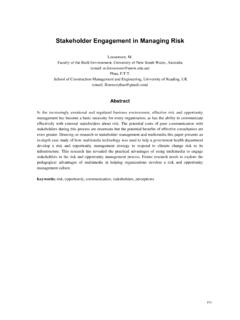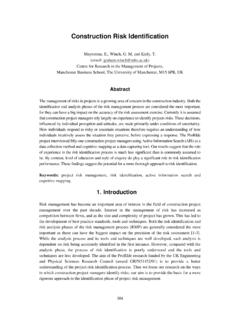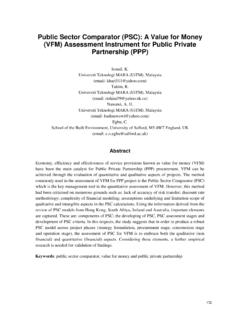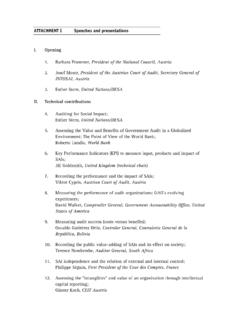Transcription of DEFINING THE SCOPE OF THE CONSTRUCTION SECTOR
1 89 DEFINING THE SCOPE OF THE CONSTRUCTION SECTOR Andrew Foulkes, Les Ruddock Salford Centre for Research and innovation , The University of Salford, UK E-mail: ABSTRACT: DEFINING the SCOPE of the CONSTRUCTION SECTOR is a key component to the wider view of valuing the SECTOR , and to evaluating the contribution it makes to the economy. DEFINING and thus measuring the size of the SECTOR is not a simple task; the SECTOR comprises several industries that are involved in different stages of the CONSTRUCTION chain. The Pearce Report on The Economic and Social Value of CONSTRUCTION (2003) sets out two opposing definitions, a narrow definition, and a broad one. This paper sets out to assess the definitions, and to ascertain what should be included in the SCOPE used to both value the industry and to examine its importance to the economy. Keywords - CONSTRUCTION SECTOR , DEFINING CONSTRUCTION , Valuing CONSTRUCTION .
2 1. INTRODUCTION Valuing the CONSTRUCTION industry, and assessing the importance of the industry to the economy as a whole is a difficult yet important task. Highlighting the importance of CONSTRUCTION to the economy is a key point to ensuring it is a high priority for government agendas. This is true not only for the UK but for all countries, and has special significance to newly developed and developing countries, as it can provide a basis for driving the country into development, with a well functioning infrastructure in place that will ensure alternative industries will have the appropriate working environment in which they can grow, as well as creating the right starting point for an energy efficient country which can aim to be sustainable in an environmental context. There is a distinction between the value to the economy and the value in the economy, both of which will vary vastly dependent upon the definition of the SECTOR used.
3 The value to the economy considers the CONSTRUCTION industry s use as a driver for growth, and as a catalyst for other industries to do well. A good CONSTRUCTION SECTOR will usually ensure a healthy level of business across the board, as the necessary infrastructure for such actions to occur will be in place. The implicit value in the economy is more easily defined and assessed, and is measured as the contribution to Gross Domestic Product (GDP). However both assessments still rely on a consistent definition of the SECTOR so that reliable and comparable estimates can be made. DEFINING the SECTOR itself is not straightforward. The Pearce Report on The Economic and Social Value of CONSTRUCTION (2003) put forward the narrow and broad definitions of the industry with the narrow definition concerning itself solely to on-site CONSTRUCTION activity, and the broader definition also encompassing the quarrying of CONSTRUCTION materials, the manufacture of building materials, the sale of the final products and associated professional services such as facilities management.
4 As the CONSTRUCTION SECTOR increasingly diversifies, the need for DEFINING the industry becomes more apparent, with many traditional CONSTRUCTION firms looking to broaden the SCOPE of activities they participate in, thus putting more emphasis on the need for a broader definition, with well-defined boundaries. Any definition will need to encompass the entirety of the CONSTRUCTION life cycle from the materials extraction stage, through the production of a final product and including the after sales service, all of which creates part of the process of producing and maintaining the built environment. 902. CONSTRUCTION S CONTRIBUTION IN THE ECONOMY The CONSTRUCTION industry has an important role to play within the overall economy of any given country. How that role manifests itself will vary greatly from one nation to another, in developing countries it is likely that the extraction of raw materials and the on-site CONSTRUCTION activity is of most importance, as the country seeks to set up a significant infrastructure, in the form of roads, railways and buildings.
5 In more developed countries, the onus will be on professional services and the sale of the end products. It is also possible that a large DIY and maintenance SECTOR will emerge the longer the main infrastructure has been in place, as potential customers seek to maintain and update current dwellings or work places rather than looking to a new building altogether. This is particularly true in the current climate in the UK where high house prices, rising interest rates, and a high cost of actually moving in terms of stamp duty, legal fees, estate agent fees and removal services means the attraction of improving the current dwelling is much higher than ever before, especially when coupled with falling costs of extensions and conservatories. Broadly speaking, the CONSTRUCTION industry is part of the process creating and sustaining the built environment. In a narrow view, the CONSTRUCTION industry is placed solely in the secondary SECTOR , as these accounts for the transformation from manufactured materials into a final product.
6 However the reality is that the CONSTRUCTION industry spans across the primary, secondary and tertiary sectors, as the process sees raw materials transformed into manufactured materials and then on into a final product, with professional services and sale of products at the end of the line. The weightings of each part of the chain will vary from one country to another, skewed according to their level of development, with a higher concentration of primary and secondary SECTOR firms in developing countries and much more tertiary SECTOR firms in developed countries such as the UK. The CONSTRUCTION industry contributes greatly to the GDP of the country. Using the narrow view this is about 6% of GDP but using the broad view it is nearer 20% in the UK, using the definitions from the Pearce Report (2003) (with more detailed analysis of certain sectors) as outlined in section DEFINING the SECTOR , and using data from the UK Input-Output Tables (2005), which is presented in a standardised format, an International Standard Industrial Classification of all economic activities (ISIC) agreed by the United Nations to allow international comparisons.
7 For comparisons just within the member states of the European Community, The General Industrial Classification of Economic Activities within the European Communities (NACE) is also in place. Another factor that makes the CONSTRUCTION SECTOR of utmost importance to the economy is the role it plays in sustainable development by the proper implementation of a sound infrastructure the basis for sustainable development is laid in place. Coupled with ever advancing technologies into new build, and similar technologies applied to maintenance and alteration of existing builds, the CONSTRUCTION industry plays a key role in ensuring a country can sustain a given level of development. Sustainability is increasingly becoming high priority to more and more countries. According to Sustainable Development and the Future of CONSTRUCTION (CIB, 1998), the drive for sustainability identifies economic, social and cultural aspects as part of the sustainable CONSTRUCTION framework, but special regard is given to ecological impacts to the environment, with more countries joining environmental pacts, and with fossil fuels and exhaustible materials for building becoming more scarce, the CONSTRUCTION industries part in sustainable development is becoming more important.
8 Building projects that incorporate energy saving schemes such as advanced insulation, or natural energy creating technologies such as solar panels, or indeed that use novel materials in the physical build contribute to sustaining the environment and thus aid the overall objective of sustainable development. 913. DIVERSIFICATION IN CONSTRUCTION As little as 20 years ago, CONSTRUCTION firms dealt solely with the build of the actual project in hand. Over the years, however, these firms have begun to diversify both upstream and down stream. Many CONSTRUCTION firms now run their own mining branches, to provide themselves and others with the raw materials needed to create the manufactured materials that go into the on-site process. They have also moved towards providing services after the final product has been made, these include the sales of the products themselves and in many cases the security and maintenance of those products.
9 The maintenance can include, window cleaning, repairs, cosmetic upkeep, and there is also the management of these services, which has created a new work branch under the heading of facilities management. The reason for this diversification is varied. Some firms have moved into other areas as it is cheaper for them to provide the service themselves than to pay for someone else to do it. Other firms have reacted to the volatility of the CONSTRUCTION SECTOR . By diversifying they can ensure that their firm will stay afloat. The CONSTRUCTION industry has a high rate of firms becoming insolvent due to the high level of competition, especially within a regional context. Diversification means that, if one branch suffers due to the effects of high competition then another branch can become the main priority of the firm. A diversified firm may also be more attractive to potential clients, as a much fuller package can be offered from the initial design stage right through to the maintaining of the final product, with no need for several different firms to be brought in.
10 Usually where diversification within a firm exists the firm can benefit from economies of specialisation, the more the firm branches out, or indeed the more the industry as a whole branches out, the more benefit can be gained. Profits usually attributed to other firms in a stream of varying workforces can lie within the same firm once successful diversification has been achieved. In recent years however, alternative firms have begun to offer similar services, large firms such as Marks and Spencer now also offer services such as security, realising they could provide the service for themselves rather than pay the CONSTRUCTION firm who built their store or warehouse. Realising the potential of such extra branches these companies have now also started to offer the services further afar in order to make themselves more diversified and gain from similar benefits as the CONSTRUCTION firms have done.

















